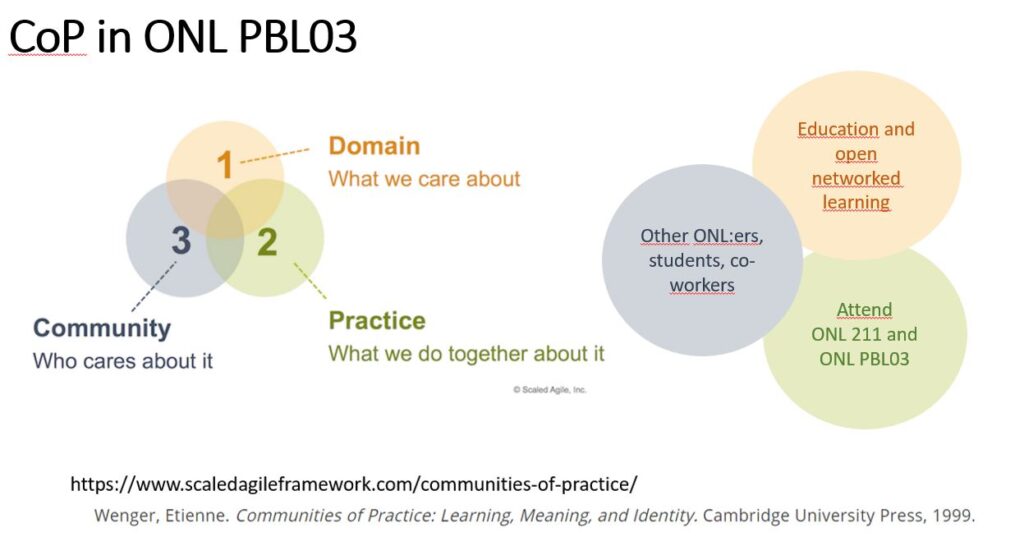Time to make a blog-friendly summary of topic 3: Learning in communities- networked collaborative learning. This time I will try to make a slightly shorter blogpost.
This topic, for me, was a bit easier to grasp compared to topic 2. As a nursing educator I have quite some experience of networking as we do a lot of work-based education. To interact and learn together with peers is an important part of nursing training. Even in my assigned mission av quality coordinator for the health educations at my institution, I know the importance of collaboration. I is true that collaboration and networking definitely can raise the quality. It is important to be able to optimize learning communitites even online, which of course is the focus of ONL211.

A common context
My deep dive for the investigation of the topic was about creating a common context. The context is an important part of an community of practice (CoP) [1]. What the context of a CoP are of course comes naturally if it is e.g. a research collaboration within a special field. But it also might be created or claryfied like e.g. within a group of students. One important part of the context is the physical context like the place or site (may of course be online) and common collaboration tools. The second part is the social context, where a joint commitment is required (or at least some guidelines on commitment and an agreement on who puts in the most effort).
In a previous course, I have together with colleagues worked with Gillan Salmons 5- stage model [2]. We then used the second step in the stair as a way of successfully visualise our common context. Got a hint from our co-facillitator that we will use tha 5 stage model later on in ONL, and I look forward to that.
My personal experience of PNLs
In relation to my own PNLs, these have mainly existed physically in relations too engaged and committed colleagues, a national pedagogy conference I attend annually and an educator Facebook community. Perhaps this course can be a kick-start for me to broaden into a larger network. Through ONL, I have already met so many people who contribute to my learning experience. I got many tips and ideas from being introduced to the work of Kay Oddone [3].
Our group work
As I wrote about before,my PBL-group PBL03 is the best bunch of people! We communicate so well, and share the experience by trying out all sorts of different tools. This time we have used ToolBox [4]. A very easy-to-learn and informative tool to visualise and share information. I think this tool can be excellent for presenting research data on comferences, but also for collaboration i groups.
Soon to fininsh- some words about theetchat!
Even this time, I attended the tweetchat. But this time only as a spectator. Due to time limits, I was only able to watch while at the same time using my hands for eating a hot bowl of soup. Fewer participants this time I noticed. Since last time I have reflected further on the uses of Twitter, and I have landed in my thoughts of not going to give it another try. I have come to a conclusion that it is better to use the chat function in Zoom to do things like this. As one of my fellow PBLers said: what you write on Twitter will 1) be broadcast out to all your followers + 2) stay there and be searchable forever. What I, or my students, will like to add to a specific topic does not need to be casted out, it is most of the time enough that it is kept in our own context or our network.
Ok, I will stop now.
I told you this would be a short text, but it got quite long anyway. I have so many thougts about this and could continue to write. But I end it here with a wish for a nice weekend!
References:
[1] Cambridge, D. and Suter, V. (2005). Community of Practice design guide: A step-by-step guide for designing & cultivating communities of practice in Higher Education. EDUCAUSE Learning Initiative (ELI).
[2] The five stage model by Gilly Salmon. (Web page): https://www.gillysalmon.com/five-stage-model.html
[3] Oddone, K. Hughes, H. and Lupton, M. (2019) Teachers as connected professionals: A model to support professional learning through personal learning networks. International Review of Research in Open and Distance Learning, 20 (3), pp. 102-120
[4] Link to the collaboration tool Learning Toolbox. (Web page): https://my.ltb.io/#/
Thank you, Christina. I like the Domain, Community, Practise diagram. I also respect your thoughts on Twitter, and I do agree with them. Wishing you well for the last three weeks of ONL211!